List of surviving Supermarine Spitfires
The Supermarine Spitfire is a British single-seat fighter aircraft used by the Royal Air Force along with many other Allied countries throughout the Second World War and afterwards into the 1950s as both a front line fighter and also in secondary roles.
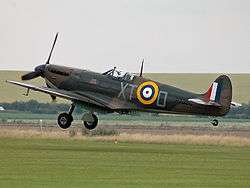
Many developing countries purchased Spitfires as industrial countries phased out propeller-powered aircraft in favour of new jet-engined machines.[1] As these nations started to update their air forces many Spitfires and other Second World War aircraft were sold on the open market to individuals or for scrap. The aircraft in Hong Kong serving with the UK Colonial wings are a good example of the different means of disposal where they were simply bulldozed into the sea as part of the process to reclaim land from the water in order to lengthen the runway.[2]
Private collectors began to acquire Spitfire aircraft and a number went on to appear in movies and TV shows. These movie and TV appearances, in turn, helped to save a number of them from being scrapped. The Spitfire with probably the most movie and TV credits is a Mk.IX MH434.[3] It ended up in civilian ownership in the UK around 1963 and has since gone on to appear in many films and TV shows including The Longest Day (1962), The Battle of Britain (1969), A Bridge Too Far (1977), and Piece of Cake (1988).
Many Spitfire and Seafire aircraft survive in museums and private collections around the world today and this article lists individual aircraft known to still exist.
Surviving Spitfires
Below is the list of Spitfires surviving organised by where they are based in the world and the condition they're in.
| Condition as stated below | Number listed below |
|---|---|
| Airworthy | 60 |
| Static Display | 56 |
| Restoration / Stored (Not on Public Display) | 39 |
Australia

- Airworthy
- Spitfire HF Mk.VIIIc MV239 / A58-758 (VH-HET). Owned and operated by the Temora Aviation Museum in Temora, New South Wales. It wears the markings of the mount of Robert 'Bobby' Gibbes DSO DFC as A58-602 / RG-V (RAF serial MV133), who was Wing Commander 80 Wing RAAF, Morotai, 1945.[4]
- Spitfire LF Mk.XVIe TB863 (VH-XVI). Owned and operated by the Temora Aviation Museum in Temora, New South Wales. It wears 453 Squadron RAAF codes TB863 / FU-P, which it wore in the UK during 1945.[5]
- Spitfire LF Mk.XVIe TE392 (VH-XWE). Owned by Fighter Pilot Adventure Flights in Australia. Not much is known about its service with the RAF, but it was a gate guard at a number of RAF airfields, including RAF Kemble and RAF Hereford, between 1952 and 1984. Originally built as a low-back airframe with a 'bubble' canopy, it made its way into civilian ownership and was restored into high-back configuration and flew once again in Florida on Christmas Eve (24 December) 1999 with the FAA register N97RW[6]. It was owned by the Lone Star Flight Museum (LSFM) in Galveston, Texas and was in storage following damage sustained during Hurricane Ike.[7] It wore the markings and colours TE392 / ZX-Z to represent the personal mount of Sqn Ldr Lance C. Wade No. 145 Squadron RAF, a Texan who flew with the RAF from 1940 to 1944 and went on to become an ace.[8]. The FAA tail number was cancelled on 19 December 2018 and was sold to Fighter Pilot Adventure Flights in Australia[9], who firstflew it again on 13 January 2020[10].
- Static Display
- Spitfire F Mk.IIa P7973. This Spitfire was flown by several Royal Air Force (RAF) and Royal Australian Air Force (RAAF) squadrons in 1941. Assigned to No. 452 Sqn (RAAF) (RAF Kenley and RAF Hornchurch) Flown by Australian pilot "Bluey" Truscott on "Circus 68", a bomber escort mission into France on 9 August 1941. This was the mission in which famous legless RAF pilot Douglas Bader was shot down and became a P.O.W. Aircraft has not been repainted since WW2 however bears the markings of the Central Gunnery School. (Coded R-H) flying 24 operations. In July 1945 it was shipped to Melbourne, Victoria, Australia for display. One of the few Spitfires still in its original paint, it has been displayed in the Australian War Memorial in Canberra since 1950.[11]
- Spitfire F Mk.Vc Trop BS231 / A58-92. Partial airframe on display at the Australian Aviation Heritage Centre, Darwin, Northern Territory. Recovered during 1983 at low-tide from wartime water crash-site, Point Charles NT. Display incorporates parts from both BS178 / A58-70 & JG731 / A58-172.[12][13]
- Spitfire F Mk.Vc Trop EE853 / A58-146. Displayed at The South Australian Aviation Museum, Port Adelaide, South Australia. This aircraft was manufactured in 1942 by Westlands in the UK. It was shipped to Australia and became part of RAAF 79 Squadron at Milne Bay. On 28 August 1943, it crashed on Kiriwina Island and was transported back to Goodenough Island. In 1971 Langdon Badger found the aircraft and in 1973 he had it shipped to Adelaide. After four years of restoration at Parafield Airport, Langdon displayed the Spitfire at his Adelaide home. In August 2001 the aircraft was put on display in the Museum.[14]
- Spitfire F Mk. 22 PK481. Displayed at the RAAF Association Aviation Heritage Museum, Bull Creek, Western Australia. The aircraft was acquired from the Brighton & Hove Branch of the Royal Air Force Association in the UK in 1959 and was initially displayed outside on a pole before being brought into the museum and refurbished in 1977.[15]
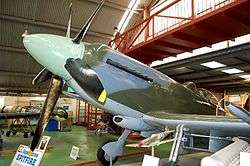
- Restoration / Stored (Not on Public Display)
- Spitfire F Mk.Vc Trop BR545 / A58-51. Owned by the Royal Australian Air Force Museum and in storage at Point Cook, Victoria. Ex. 54 Sqn Royal Australian Air Force (RAAF) machine, marked DL-E. Force landed on mudflats at low-tide, Prince Regent River, near Truscott WA 22 December 1943. The wreck lay for many years covered by the tides until recovered by the RAAF Museum in November 1987. Merlin engine and sections of airframe recovered.[12][13]
- Spitfire F Mk.IX MH603 (VH-IXF). Owned by Ross Pay (son of Col Pay) and registered to Pay's Air Service Pty Ltd. Ex. South African Air Force machine MH603 is under active restoration to airworthy condition at Scone, NSW. When completed the Spitfire will wear 331 (Norwegian) Squadron colours as based at North Weald (UK) in early 1944.[16][17]
- Spitfire LF Mk.IXb MJ789. Owned by the Royal Australian Air Force Museum and in storage at Point Cook, Victoria. Ex. 453 (RAAF) Sqn machine, wore the markings MJ789 / FU-B. Crashed in River Orne, near Caen, France on 11 June 1944 as a result of anti-aircraft fire claiming the life of pilot Flight Lieutenant Henry 'Lacy' Smith. Both F/L Smith and MJ789 were recovered from the riverbed in November 2010. Subsequently, F/L Smith was buried with full military honours in Normandy and the wreckage of MJ789 was transferred to the RAAF Museum and transported to Australia for conservation with a view to eventual display.[18]
- Seafire F Mk.XV SW800 (VH-CIH). In storage, Adelaide area, South Australia. Recovered from Brownhills scrapyard in the UK circa 1991, and shipped to Melbourne VIC.[12]
Belgium
- Airworthy
- Spitfire LF Mk.XVIe SL721 (OO-XVI). Owned by Vintage Fighter Aircraft. Refinished in the markings of AU-J from No. 421 Squadron RCAF and was part of the Gatineau, Quebec based Vintage Wings of Canada's collection, registered as C-GVZB.[19] It was sold to Vintage Fighter Aircraft in Belgium[20] in airworthy condition and is registered as OO-XVI[21].
- Static display

- Spitfire LF Mk.IXe MJ783/SM15. Painted as MJ360 / GE-B from Royal Air Force 349th (Belgian) Squadron, on display at the Royal Museum of the Armed Forces and Military History in Brussels . [22]
- Spitfire FR Mk.XIVc MV246. on display at the Royal Museum of the Armed Forces and Military History in Brussels . Delivered to the Belgium Air Force with the Belgium tail number SG-55. Restored in 1951 with parts from other written-off Belgian Spitfires and displayed with the squadron codes GE-R. [23]
Canada

- Airworthy
- Spitfire HF Mk.IXe TE294. Previously under restoration to flying condition at Comox, British Columbia, for Vintage Wings of Canada, it arrived at their main base at Gatineau, Quebec in late September 2014 for continued restoration back to airworthy condition. Finished to represent MK304 / Y2-K. First flight after restoration took place at Gatineau, Quebec, 7 June 2017.[24]
- Static Display
- Spitfire Mk. XVIe TE214. On display at the Canadian Warplane Heritage Museum, in Mount Hope Ontario, on loan from the Canada Aviation and Space Museum in Ottawa, Ontario. It was built by Vickers at Castle Bromwich, UK, in 1945 and it flew post-war with RAF No. 203 Advanced Flying School until it was damaged in an accident. The British Air Ministry presented it to the RCAF in 1960 and it was transferred it to the Canadian Aeronautical Collection, now the Canada Aviation and Space Museum in 1966.[25]
- Spitfire F Mk.IIb P8332. Battle of Britain veteran, on display at the Canadian War Museum, Ottawa. It wears the markings and codes P8332 / ZD-L of 222 Sqn to replicate the scheme it wore when serving with the Squadron during 1941. Presentation aircraft, "SOEBANG N.E.I.", funded by the Netherlands East Indies.[26]

- Spitfire LF Mk.IXc NH188. Served with the Royal Netherlands Air Force as H-109 (later H-64) from 1947 to 1952 and with the Belgian Air Force as SM-39 from 1952 to 1954. Privately owned, it was flown in Belgium as OO-ARC and was later imported to Canada where it flew as CF-NUS. After being donated on 7 June 1964, it is now on display in the Canada Aviation and Space Museum in Rockcliffe, Ontario as NH188 / AU-H.[27]
- Restoration / Stored (Not on Public Display)
- Spitfire F Mk.XIVe RM747[28] In storage at Vintage Wings of Canada, Gatineau, Quebec, Canada. RM747 served with No.322 (Dutch) Sqdn, No.350 (Belgian) Sqdn, No.451 (Australian) Sqdn, before serving with the Royal Thai Air Force as serial number Kh.14-5/93. During the 1980s it was part of a playground at Sawankalok, Thailand.[29]
China
- Static Display
- Spitfire LF Mk.XVIe TE330. Displayed at the China Aviation Museum, Datangshan. Acquired in 2008 from New Zealand where it underwent restoration to static display condition by the Subritzky family of North Shore and sold to China via auction.[30]
Czech Republic
- Static Display
- Spitfire LF Mk.IXE TE565. Served with No. 310 (Czech) Squadron as A-712. Transferred to Czech Air Force in 1945 and put on display in the National Technical Museum from 1950 to 1970 when it was loaned to the Kbely Aviation Museum. In 2008 it was moved back to the National Technical Museum and put on static display as TE565 / NN-N.[31]
Denmark
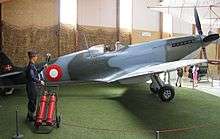
- Static Display
- Spitfire HF Mk.IXe MA298. After the German occupation, the Royal Danish Air Force acquired 38 HF Mk.IXe and 3 PR Mk.XI Spitfire aircraft. The Spitfires were phased out and replaced by jets between 1951 and 1955. All but two were scrapped. For a number of years, one was placed in a children's playground. The last survivor is exhibited at Danmarks Flymuseum, Stauning Airport.[32] It wears the authentic Royal Danish Air Force markings 41-401.
France
- Airworthy
- Spitfire PR.XIX PS890. Entered service 1945. To Royal Thai Air Force as U14-26/97, in service until 1952. Donated to Planes of Fame Air Museum in 1962. Restored to airworthy condition in 2002 as N219AM. Sold to French owner in 2005, re-registered F-AZJS.[33] Damaged in a take-off accident at Longuyon-Villette Airfield, Meurthe-et-Moselle on 11 June 2017. Currently at Duxford, UK, under restoration to flight [34]. The Spitfire was rebuilt and flew again on 6 August 2020.
- Static Display
- Spitfire LF Mk. XVIe RR263. Built in 1944 and delivered to the RAF that year with 2nd Tactical Air Force. The Spitfire was loaned to Vickers Supermarine for experimental reasons in 1949 before moving to storage. Used as a static backdrop of for the Reach for the Sky movie and later was on a plinth at RAF Kenly as TB597/GW-B. Later overhauled and repainted as TB597/GW-B before being put on display at Musée de l'Air, Le Bourget.[35]
Germany
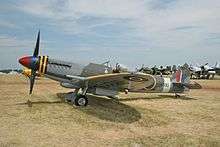
- Static Display
- Spitfire FR Mk.XIVe MV370. On display at the Luftfahrtmuseum, Hannover. Ex-Indian Air Force instructional airframe (marked T.44), wears the codes MV370 / EB-Q to represent a machine from No. 41 Squadron RAF.[36]
Greece
No Spitfires are currently based in the Greece, but Spitfire MJ755 (under restoration in the UK) will be based in Greece once the restoration is completed.
India
- Static Display
- Spitfire F Mk.XVIIIe - SM986. On display at the Indian Air Force Museum, Palam, New Delhi.[37] Indian Air Force serial HS986.
- Spitfire Mk.VIII - MV459. On display at the Ambala Air Force Station.[38]
Israel

- Airworthy
- Spitfire LF Mk.IXe TE554. The Black Spitfire, and former Israeli Air Force 20-57. The personal mount of former Israeli Air Force Chief of Staff and president Ezer Weizman, it is used for ceremonial flying displays and based at the Israeli Air Force Museum in Hatzerim.[39][40]
- Static Display
- Spitfire F Mk.IXe EN145. Built at Chattis Hill, it first flew in 1942 and was delivered to the USAAF in 1943[41]. It was later delivered to the Italian Air Force in 1946 before being delivered to the Israeli Air Force as 20-78. EN145 was acquired by the IDFAF Museum in 1990 and has been on display ever since[42].
- Spitfire LF Mk.IXe TE578. Delivered to the Czechoslovakian Air Force before being delivered to the Israeli Air Force as 20-28. It was later acquired by the IDFAF Museum in 1973 where it's on display[43]. This Spitfire has commonly been mistaken for SL653, another Spitfire which saw service with the IDFAF.
Italy
.jpg)
- Static Display
- Spitfire LF Mk.IXc MK805. On display at the "Vigna di Valle Museum" (Italian Air Force Museum) Bracciano, Rome, Italy.[44]
Malta
- Static Display
- Spitfire F Mk.IXe EN199. On display at the Malta Aviation Museum, Ta Qali, Malta. First flown at Eastleigh on 28 November 1942. The aircraft was restored by Ray Polidano, the Museum's Director, in 1992. The aircraft is named 'Mary Rose' in honour of Ray Polidano's wife and carries the code R-B in memory of the highest-ranking officer who flew it - Wing Commander Ronald Berry D.F.C.[45]
Myanmar (Burma)
- Static Display
- Spitfire LF Mk.IXe TE513 / UB421. On external display at the newly opened (2016) Defence Services Museum which is North-East of Myanmar's capital city, Naypyidaw, in the Zeyathiri Township.[46]
- Spitfire LF Mk.IXe TE527 / UB431. Rear fuselage and tail-section suspected to be from this aircraft on display within the newly opened Defence Services Museum on the outskirts of Naypyidaw.[46]
- Seafire F Mk.XV PR376 / UB409. On external display at the newly opened (2016) Defence Services Museum on the outskirts of Naypyidaw.[46]
- Possible buried Spitfires in Burma
In 2012 a great deal of media attention was given to rumours that the RAF had buried a number of Spitfire Mk.XIV aircraft in Burma, unassembled and in their packing crates, during August 1945. However, no documentary or other evidence has been uncovered that this actually happened and some have dismissed the whole story as implausible, including military archaeologist Andy Brockman[47]
During April 2012 the UK government announced they were working with the post-junta Burmese government to locate and potentially return a total of 20 aircraft to flying condition. On 16 October 2012, the Burmese government signed an agreement with David Cundall, a British farmer and aviation enthusiast who was leading the search along with his Burmese business partner Htoo Htoo Zaw, allowing them to begin excavations.[48]
Leeds University experts and an academic from Rangoon using sophisticated radar techniques claimed to have discovered one of the sites of the buried aircraft at what is now Yangon International Airport, the former RAF Mingaladon airfield. In addition to the 20 aircraft thought to be at this site, other sites with buried Spitfires were claimed, one with as many as 36 aircraft interred.[49][50]
In January 2013, following investigations at both Yangon International Airport and Myitkyina, archaeologists led by Andy Brockman concluded that there were no aircraft buried at the sites.[51] Despite this, David Cundall continued his search.[52] However, on 16 February of the same year, it was reported that Cundall's sponsors, Wargaming Ltd, no longer believed any Spitfires were ever buried and that any aircraft in the area had been re-exported in 1946. The search was called off.[53] Despite the withdrawal of the major sponsor, David Cundall said at that time that he remained confident and the search would continue.[54]
The Netherlands

- Airworthy
- Spitfire LF Mk IXc MK732 (PH-OUQ). Operated by The Historic Flight of the Royal Dutch Air Force (Koninklijke Luchtmacht Historische Vlucht) and based at Gilze-Rijen. Built in 1943, it saw action during D-Day. Following the restoration to flight, it initially carried the Dutch Air Force (Klu) markings H-25. Following this it was painted in the scheme it wore when serving with 485 (RNZAF) Sqn as OU-U / BABY BEA V, but now wears an all-over silver scheme 3W-17 / MK732 of the Royal Netherlands Air Force.[55]
- Static Display
- Spitfire LF Mk.IXc MJ143. On display at the newly opened National Military Museum sited on the former Royal Netherlands Air Force Base at Soesterberg. Previously in storage after being on display for many years at the now closed Militaire Luchtvaart Museum also at Soesterberg. Displayed as H-1, Royal Netherlands Air Force.[56]
- Spitfire FR Mk.XVIIIe TP263, Displayed at the National War & Resistance Museum. Ex-Indian Air Force HS649, rebuilt to represent a Mk.XIVc. Wears the spurious serial NH649, with the codes 3W-F of No.322 (Dutch) Squadron.[57]
New Zealand
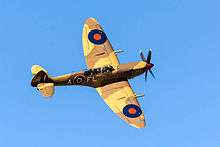
- Airworthy
- Spitfire Tr.9 MH367 (ZK-WDQ). Owned by noted aerobatic pilot Doug Brooker and arrived in New Zealand on 11 September 2008. It wears RAF desert colours with the markings of FL-A, a Mk IX flown by the New Zealand Squadron Leader Colin Gray, C/O of 81 Squadron when based in Tunisia in mid-1943.[58] On 15 January 2009, during a transit flight from Auckland, the Spitfire suffered a heavy forced landing on Hood Aerodrome, near Masterton. The propeller, undercarriage and some fuel lines were damaged but the aircraft was repaired.[59] A second landing accident at Ardmore Airport on 2 December 2009 resulted in damage to the undercarriage and propeller. It is believed that a sudden change in wind direction caused the aircraft to run off the end of the runway.[60] On 12 June 2011 the aircraft suffered yet another landing accident, this time tipping onto its nose after landing at Ardmore, damaging the propeller[61]
- Spitfire LF Mk.IXc PV270 (ZK-SPI). Owned by businessman Brendon Deere and restored to an airworthy condition over five years at Feilding, New Zealand, it flew again on 18 March 2009.[62] The aircraft is based in a purpose-built hangar at RNZAF Base Ohakea along with Brendon Deere's North American Harvard.[63]
- Spitfire FR Mk.XIVe NH799 (ZK-XIV). Owned by 'The Chariots of Fire Fighter Collection' and based at Omaka airfield, New Zealand. Post restoration first flight 2 April 2015, with John Lamont at the controls. Purchased by the Chariots of Fire Fighter Collection, who are based at Omaka, in 2010. Restored to airworthy condition by Avspecs Limited at Ardmore Airport, Auckland.[64]
- Static Display
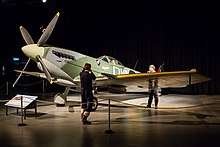
- Spitfire LF Mk.XVIe TE288. Taken on charge by the RAF on 1 June 1945, the aircraft served with 61 OTU, 501 RAuxAF Squadron (coded RAB-D), and 102 and 103 Fighter Refresher Schools, until placed into storage in 1951. Also used as a prop in the movie "Reach for the Sky", it then spent time as a gate guard at RAF Rufforth, Church Fenton and finally Dishforth, before it was sold in 1963 to Canterbury Brevet Club, Christchurch, New Zealand. For many years it was mounted on a pole near the entrance to Christchurch International Airport. In 1984 it was donated to the RNZAF Museum and was restored by RNZAF staff at RNZAF Woodbourne. It is displayed at Wigram, without the serial number, as 'OU-V' of 485 Squadron.[65]
- Spitfire LF Mk.XVIe TE456. Taken on charge by the RAF on 8 August 1945, the aircraft initially went into storage at 6 MU at Brize Norton. It was issued to 501 RAuxAF Squadron at Filton in March 1946 (coded RAB-J), and then to 612 RAuxAF Squadron at Dyce in May 1949 (coded '8W-?'). In August 1955 it was used in the movie Reach for the Sky. It has been on static display at the Auckland War Memorial Museum, New Zealand, since 1956 when New Zealander Sir Keith Park, commander of No 11 Fighter Group, arranged for it to be donated.[66]
- Restoration / Stored (Not on Public Display)
- Spitfire FR MK.XVIe TB252 (ZK-NLJ). Delivered to RAF 329 Squadron on 1 March 1945. It later served with 350 Squadron of Belgian Air Force before it became a gate guardian in 1955. It remained as a monument until 1988 when it was acquired by Historic Flying. Now under restoration to fly by Avpsecs in Ardmore, New Zealand.[67]
Norway
- Static Display
- Spitfire LF Mk.IXe MH350. On display at the Norwegian Aviation Museum (Norsk Luftfartsmuseum), Bodø.[68]
- Spitfire PR Mk.XI PL979. On display at the Norwegian Armed Forces Aircraft Collection, Gardermoen, Oslo.
- Restoration / Stored (Not on Public Display)
- Spitfire Mk IX EN570. Ex Royal Air Force, shot down at Saint-Pol-sur-Ternoise, France in 1943. Under restoration to flying condition for Norwegian Flying Aces incorporating new fuselage and wings.[69]
- Spitfire Mk IX, MJ785, Ex Royal Norwegian Air Force, crashed in the summer of 1945. Under consideration for restoration to flying condition for Norwegian Flying Aces.[69]
- Spitfire LF Mk.IX MK997. Ex Royal Norwegian Air Force, which crashed into Samsjøen Lake in August 1950, killing the pilot. Wreckage raised on 13 August 2018. To be restored to flying condition for Norwegian Flying Aces.[69]
Poland
- Static Display
- Spitfire LF Mk.XVIe SM411. Assigned to RCAF 421 Sqn in 1944. On display in the Polish Aviation Museum, Kraków.[70] It wears the spurious markings TB995 / ZF-O of 308 (City of Kraków) Sqn RAF. In 1977, this aircraft was sent from the United Kingdom to Poland as part of an exchange between the Polish Aviation Museum and the Royal Air Force Museum. It was swapped for a World War 1 Airco DH.9A bomber, the only survivor of its type, which is now on display at the Royal Air Force Museum London. Difficulties caused by the then ongoing Cold War meant nearly nine years were spent negotiating the swap.[71]
Portugal
.jpg)
- Static Display
- Spitfire HF Mk.IXc ML255. Delivered to the South African Air Force in 1948. After being damaged in a collision at AFB Ysterplaat, it ended up derelict in Snake Valley, Pretoria until it was recovered and restored to static display for the SAAF Museum. It was later transferred to the Museu do Ar, at Sintra in Portugal.[72] It wears the Portuguese Air Force markings ML255 / MR+Z.
Serbia
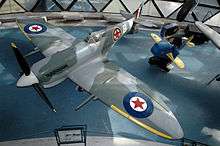
- Static Display
- Spitfire F Mk.Vc Trop JK808, ser.no. 17-545,[73]
On display at Belgrade Museum of Aviation. Aircraft appears in 352 (Yugoslav) Squadron RAF in March 1945. It flew in 11 missions over former Yugoslavia. Transferred to 1st Fighter Aviation Regiment of Yugoslav Air Force, May 1945, then to Mostar Air Base HQ (today in Bosnia and Herzegovina) in August 1945. In 1949, received YAF serial 9489. Briefly in 112th Fighter Aviation Regiment as a training aircraft, then stored at Mostar. Between 1947 and 1952 in 103rd Reconnaissance Aviation Regiment. Suffered belly landings in February 1949 (left tire fell off on take-off) and February 1950 (engine malfunction). All remaining Spitfires were retired on 18 August 1952.
While others were scrapped or turned into instructional airframes, 9489 (ex JK808) was handed over to Military Museum in Belgrade. It was put on static display first at Kalemegdan (Belgrade fortress) as a part of the outdoor museum exhibition. There it received a new coat of paint and an incorrect YAF number 9486. After that it was displayed at Belgrade International Airport, as a part of Belgrade Museum of Aviation exhibition, in a purely fictional paint scheme and markings.[74]
This caused confusion about aircraft true identity. Spitfire with YAF number 9486 was ex-RAF MH592, which ended as instructional airframe at Rajlovac Air Force Technical Training Center,[74] but it is still claimed by some sources (not related to the Museum) to be the aircraft displayed in Belgrade.
Aircraft 9489 (JK808) was thoroughly restored during 1973 by Tehnička direkcija JAT ( JAT Tehnika ) at Belgrade International Airport. After detailed investigation and several paint schemes applied (JK448 code name "W" notably) the true identity of this aircraft was confirmed, based on serial numbers found and archive material as JK808, airframe s/n 17-545, built at Castle Bromwich.[73] An article about restoration and the search for true identity was published in 2004.[75] (published in Serbian Cyrillic).
Aircraft on display contains several non-original parts: engine from another aircraft, Soviet-made camera, landing gear parts, re-manufactured instrument panel, standard RAF instruments and other parts from YAF or JAT stocks.[74]
South Africa
_(12136815584).jpg)
- Static Display
- Spitfire HF Mk.VIIIc JF294. South African National Museum of Military History, Johannesburg.[76] SAAF serial 5501.
- Restoration / Stored (Not on Public Display)
- Spitfire LF Mk.IXe TE213. South African Air Force Museum, AFB Swartkop. Damaged after forced landing on 15 April 2000 and restoration to static condition is underway[77] SAAF serial 5518.
Thailand
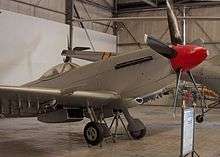
- Static Display
- Spitfire FR Mk.XIVe SM914. Royal Thai Air Force serial KH14-1/93. On display at the Royal Thai Air Force Museum, Bangkok, Thailand[78] It wears Royal Thai Air Force markings with an overall Silver scheme.
United Kingdom
- Airworthy
- Spitfire F Mk.Ia N3200 (G-CFGJ). Owned by the Imperial War Museum and operated by the Aircraft Restoration Company, based at Duxford Airfield. Ex 19 Sqn machine, it sports the QV squadron codes it wore when it was shot down on 26 May 1940 in support of the Operation Dynamo evacuation of Dunkirk with Sqn Ldr Geoffrey Stevenson, 19 Sqn OC, at the controls. N3200 was restored to airworthy condition by Historic Flying Limited, Duxford and its first post-restoration flight took place on 26 March 2014 from the airfield. Donated to the Imperial War Museum Duxford on 9 July 2015 by American billionaire and conservationist Thomas Kaplan[79] (aka Mark One Partnership LLC), accepted on behalf of the museum by its Patron, Prince William (Duke of Cambridge)[80].
_(19076877434).jpg)
- Spitfire F Mk.Ia X4650 (G-CGUK). Owned by Comanche Warbirds. X4650 was built in October 1940 and was delivered to 54 Squadron with the codes KL-A. It crashed in December 1940 before it was struck off charge in June 1941. The remains were recovered in 1976 and a restoration began at Biggin Hill and had its first post-restoration flight in March 2012[81].
- Spitfire F Mk.Ia AR213 (G-AIST). Acquired by Group Captain Allen H. Wheeler on 25 October 1946. In 1968 it flew in the film Battle of Britain. In April 1989 it was acquired by Sheringham Aviation.[82] In 2002 it underwent another restoration, repainted with 57 OTU colours, and coded "JZ-E".[83] It starred in the 2017 film Dunkirk.[84]
- Spitfire F Mk.IIa P7350. Operated by the RAF Battle of Britain Memorial Flight at RAF Coningsby in Lincolnshire. It is the only surviving Spitfire from the Battle of Britain still flying and is believed to be the 14th aircraft of the 11,989 built at Castle Bromwich. The aircraft entered service in August 1940 and during the battle served with 266 and 603 Squadrons.[85]
- Spitfire LF Mk.Vb AB910. Operated by the RAF Battle of Britain Memorial Flight at RAF Coningsby in Lincolnshire. Built at Castle Bromwich in 1941 and has a front line operational career spanning almost four years.[86]

- Spitfire LF Mk.Vc AR501 (G-AWII). Maintained in airworthy condition with the Shuttleworth Collection, returned to airworthy status in March 2018 following a rebuild.[87] AR501 was built by Westland Aircraft at Yeovil and flown by No. 310 (Czech) Squadron at RAF Duxford as AR501 / NN-A in 1942, where it escorted USAAF Boeing B-17 Flying Fortress and Consolidated B-24 Liberator bombers. Joined the Shuttleworth Collection in 1961, it featured in the 1969 film The Battle of Britain.[88]
- Spitfire F Mk.Vb BM597 (G-MKVB). Owned by Historic Aircraft Collection. Built in 1942 and delivered to 315 Squadron as PK-C and later 317 Squadron as JH-C, both Polish Squadrons stationed at RAF Woodvale. After its RAF service was complete, it became a gate guard at multiple air bases and was to make moulds for replica Spitfires for the Battle of Britain movie. In 1989, the founder of Historic Flying, Tim Routsis, made a deal with the RAF to purchase the aircraft so it could be restored. He sold it to the Historic Aircraft Colletion in 1993, who completed the restoration and had its first post rebuild flight in 1997. The aircraft is finished in its original 317 Squadron markings, but with an earlier camouflage scheme (brown and green as opposed to grey and green)[89].
- Spitfire F Mk.Vc EE602 (G-IBSY). First post-restoration flight took place on 15 May 2015 at Biggin Hill with Peter Monk at the controls. Restoration carried out over 3 years by the Biggin Hill Heritage Hangar, Biggin Hill. It wears the markings EE602 / DV-V from 129 (Mysore) Sqn RAF, along with the authentic inscription 'CENTRAL RAILWAYS URUGUAYAN STAFF' to replicate the markings it wore as a presentation aircraft donated by the British Community in Uruguay.[90]
.jpg)
- Spitfire LF Mk.Vb EP120 (G-LFVB). Owned by The Fighter Collection, based at Duxford. Built at Castle Bromwich in 1942 and delivered to 501 Squadron where it got six kills while being flown by Sqn Ldr Geoffrey Northcott. It suffered a ground collision and was repaired by CB before joining 19 Squadron. EP120 was delivered to 402 Squadron in 1944 and given the code AE-A. After the war, it became a gate guard and later, a star in the Battle of Britain movie, before moving into storage in 1989. Acquired by The Fighter Collection in 1993 and had its first flight since restoration in 1995. The aircraft is in its original 402 Squadron markings of AE-A[91].
- Spitfire F Mk.Vc JG891 (G-LFVC). Owned by Comanche Fighters, based in the UK. Built in 1942 and delivered to the RAAF as A58-178, it flew with the RAAF until it was involved in a landing accident in 1944 and was written off. The aircraft was rebuilt and flew again in 2006 with the register G-LFVC before going to the United States, registered as N5TF with the Comanche Fighters, Texas. The Spitfire was involved in a landing accident in July 2017 and was later exported back to the United Kingdom on 25 October 2017 and deregistered from the FAA civil register.[92]. It was reregistered as G-LFVC on 31 October 2017 and flew again on 6 July 2018 and is in the markings of a 249 Squadron Spitfire.[93]
- Spitfire Mk.VIII MT818 (G-AIDN). Two-seat trainer, restored to airworthy condition by Personal Plane Services, Booker, Buckinghamshire, flying on 31 March 2016. Based at Biggin Hill.[94]
- Spitfire Mk.VIIIc MV154 (G-BKMI). Airworthy in UK. Built at Supermarine Southampton in 1944, it was delivered by famous ATA-girl Mary Wilkens to 6 Maintenance Unit before it was shipped to Australia for the RAAF as A58-671. It never saw service and remained in storage until 1994, when it was rebuilt to fly with the UK civil register G-BKMI and wears the markings of Spitfire Mk.VIII MT928, a Spitfire which served with No.154 Squadron. It was later sold to Meier Motors in Germany and subsequently reregistered as D-FEUR. The aircraft suffered a prop strike in 2019 during the Battle of Britain Airshow at Duxford in September[95]. The aircraft has since been repaired by the Aircraft Restoration Company, reregistered as G-BKMI and has flown in the UK.
- Spitfire LF Mk.IXc MH415 (G-AVDJ). Owned by Warbirds Flight Club Pty Ltd, Hunter Valley NSW, being restored to flying condition.[96] Previously owned by Wilson 'Connie' Edwards and stored at his facility in Big Spring, Texas for decades. During its time with 'Connie' Edwards it wore the scheme MH415 / ZD-E to replicate the colours and markings it wore during its service with No. 222 (Natal) Squadron RAF during 1943. Its FAA registration was cancelled[97], sold via Platinum Fighter Sales in October 2015 and subsequently transported to Australia[98]. After 5 years of work, it was exported to the UK to fly right before the COVID-19 pandemic struck[99].
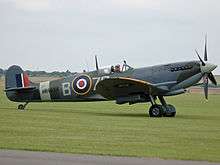
- Spitfire LF Mk.IXb MH434 (G-ASJV). Owned and operated by The Old Flying Machine Company and based at Duxford. Built at Castle Bromwich, MH434 shot down an Fw 190 in 1943 while serving on 222 Squadron. From the 1980s it was usually flown by Ray Hanna, ex-Red Arrows leader and display pilot up until his death in late 2005.[100] 'MH434' has featured at European air shows and has been in many other TV and films including Operation Crossbow, The Longest day, Battle of Britain and Foyle's War .[100]
- Spitfire Tr.9 MJ627 (G-BMSB). Serve with 441 Squadron, Royal Canadian Air Force, coded 9G-Q. Sold in 1950 to Vickers for conversion into a two-seat trainer, carried Class B markings G-15-171. To Irish Air Corps in June 1951 as 158; ground instruction airframe from April 1960. Sold to Tim Davies in February 1964, registered G-ASOZ. Sold to Maurice Bayliss in September 1976, re-registered G-BMSB. Restored to airworthy condition and flew again on 8 November 1993 marked 9G-Q. As of October 2016 owned by Warbird Experiences Ltd, based at Biggin Hill airfield.[101]
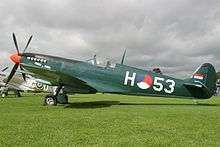
- Spitfire Mk IX MJ271 (G-IRTY) Built in 1943 at Castle Bromwich and flew 51 combat missions. Restored as 'The Silver Spitfire' by Historic Flying Limited, the first post-restoration flight took place in late June 2019 at Duxford. Finished in polished aluminium, the owners, Boultbee Flight Academy, circumnavigated the world in the aircraft.[102]
- Spitfire LF Mk.IXc MJ755 (G-CLGS). Built at the Castle Bromwich factory and delivered to No. 43 Squadron RAF in August 1944, which at the time was covering operations in Southern France. In 1947 it was transferred to the Royal Hellenic Air Force and later retired to The Hellenic Air Force Museum.[103]. In 2018, the aircraft went to the Biggin Hill Heritage Hangar in the UK to be restored to fly.[104]. The Spitfire made its first flight after restoration on 19 January, 2020.
- Spitfire Tr.9 MJ772 (G-AVAV). Served with 341 Squadron, Royal Air Force as MJ772 / NL-W then with 340 Squadron, Royal Air Force as MJ772 / GW-A. Sold to Vickers-Armstrongs in 1950, converted to two-seat trainer. Carried Class B markings G-15-172. To Irish Air Corps in May 1951 as 159. Withdrawn from flying in 1960. Sold to Film Aviation Services in November 1963 and stored at Biggin Hill. Sold to COGEA, Belgium in May 1964 and stored at Ostend Airport. Sold to Tony Samuelson in 1965 and registered G-AVAV in November 1966. Restored to airworthy condition in July 1967. Leased to Spitfire Productions Ltd for use in the film Battle of Britain. A forced landing was made at Little Staughton on 9 July 1968 due to engine failure, subsequently returned to flying condition. Later sold to Sir William Roberts and displayed as part of the Strathallan Collection, coded MJ772 / NL-R. Sold to Doug Champlin of Enid, Arizona, registered N8R. Later registered in Germany as D-FMKN.[101] Suffered off-airport landing in field, near Woodchurch, Kent, United Kingdom on 7 September 2015. Pilot uninjured.[105][106] As of March 2019, owned by Warbird Experiences Ltd, based at Biggin Hill airfield.[107]
- Spitfire LF Mk.IXe MK356. Operated by the RAF Battle of Britain Memorial Flight at RAF Coningsby in Lincolnshire. Built at Castle Bromwich and delivered to RAF Digby in 1944.[108]
.jpg)
- Spitfire Tr.9 ML407 (G-LFIX). Served with 485 Squadron, Royal New Zealand Air Force as ML407 / OU-V. Participated in Operation Overlord. Subsequently served with 341 Squadron, Royal Air Force coded ML-D, 308 Squadron, coded ZF-R, 349 Squadron, coded GE-P, 345 Squadron, coded 2Y-A and 332 Squadron, coded AH-B. To 151 Repair Unit in April 1945 and 29 Maintenance Unit in October 1945. Sold to Vickers-Armstrongs in 1950 and converted to a two-seat trainer. Flew under Class B markings G-15-175. To Irish Air Corps in August 1951 as 162. Withdrawn from service 8 July 1960 and stored. Sold to Tony Samuelson in March 1968, then to Sir William Roberts in 1970 and Nick Grace in 1979. Restored to airworthy condition in 1985, registered G-LFIX.Owned by Carolyn Grace and as of October 2016 based at Sywell, it wears the markings it wore when serving with 485 (New Zealand) Squadron.[109][101]
- Spitfire Tr.9 NH341 (G-CICK). Rebuilt to airworthy condition with ARCo at Duxford. Restored as a two-seat Tr.9.[110] A former 411 Sqn machine, it wears the codes DB-E to reflect those it wore when in service with the squadron.[111]
- Spitfire LF Mk. IXe PL344 (G-IXCC). Served with 602 Squadron, 442 Squadron with the codes Y2-P and 401 Squadron where it got some kills under the control of Squadron C.O., Sqdn Ldr Bill Klersey before the squadron disbanded in July 1945. It later joined 130 Squadron and finally 129 Squadron before suffering a wheels-up landing in 1946. Rebuilt to airworthy condition in 1991 with the registration G-CCIX. Kermit Weeks acquired the Spitfire in 1992 and was rebuilt again to near-original condition. Completed in 2000 and registered as N644TB[112] as a birthday gift for Tom Blair from his wife, Alice Blair, who bought it from Kermit Weeks. Airworthy until it was exported to the UK in 2007. Rebuilt for a third time including the fitting of fuel tanks in the wings before a post-rebuild first flight in 2007. Returned to America some time after[113] but appeared on the UK CAA register as G-IXCC in 2019.
- Spitfire Tr.9 PT462 (G-CTIX). Owned by the Aircraft Restoration Company and operated by Aerial Collective Duxford. It wears the markings PT462 / SW-A. [114]
- Spitfire Tr.9 PV202 (G-CCCA). Served with 33 Squadron, Royal Air Force as PV202 / 5R-Q, then with 412 Squadron as PV202 / WZ-M, later coded WZ-W. To 29 Maintenanc Unite in July 1945. Sold to Vickers-Armstrongs in 1950 and converted to two-seat trainer. Carried Class B marks G-15-174. To Irish Air Corps in June 1951 as 161. Flew until 1 December 1960 when withdrawn from active service due to crack in undercarriage strut. Became an instructional airframe. Sold to Sir William Roberts in April 1970, to Strathallan Collection in 1972. Sold in 1979 to Nick Grace, later sold to Steve Atkins. Registered G-BHGH, later re-registered G-TRIX. Subsequently, sold to Richard Parker and restored to airworthy condition, it was flown again after restoration on 23 February 1990. Sold to Rick Roberts in 1992. Following a major accident at Goodwood in April 2000, the aircraft was sold to Karel Bos / Historic Flying Limited, based at Duxford and was rebuilt. Re-registered G-CCCA. Returned to airworthy condition as Irish Air Corps 161, subsequently operated in Royal Netherlands Air Force livery as H-98. As of October 2016, airworthy marked as 5R-Q. Operated by the Aircraft Restoration Company and Aerial Collective Duxford, based at Duxford.[101]
- Spitfire HF Mk.IXe RR232 (G-BRSF). Built at Castle Bromwich in 1943 and returned to the UK by the late Jim Pearce in 1989, now owned by Martin Phillips, operated by the Boultbee Flight Academy and based at Goodwood Aerodrome, West Sussex.[115]
- Spitfire Tr.9 SM520 (G-ILDA). Restored to airworthy condition and purchased at auction by Steve Brooks, the first person to fly pole-to-pole by helicopter in 2005.[116]
- Spitfire HF Mk.IXe TA805 (G-PMNF). Flies from the former RAF station at Biggin Hill. After the war it was used by the South African Air Force, recovered from a scrap yard, and returned to England in the early 1990s. It wears 234 Squadron markings TA805 / FX-M.[117]
- Spitfire HF Mk.IXe TD314 (G-CGYJ). Operated by Aero Legends at Duxford. This Spitfire was built as one of the last high back Spitfires built in late 1944. It saw service in the RAF with 183 Squadron and 234 Squadron before it was delivered to the SAAF. It ended up in a scrapyard in South Africa in 1954 and later rescued in 1969. After multiple owners over many years it ended up in Canada in 2009. Aero Legends acquired in 2011 and restored it to airworthy condition, with its first post-restoration flight on 7 December 2013[118].

- Spitfire Tr.9 TE308 (G-AWGB). Initially allocated to 33 Maintenance Unit, then to 29 Maintenance Unit. Sold to Vickers-Armstrongs in July 1950. Converted to a two-seat trainer. Flew under Class B markings G-15-176. To Irish Air Corps in July 1951 as 163. Wheels-up landing on delivery at Baldonnel Airfield on 30 July. Withdrawn from service 9 September 1961. Sold to Tony Samuelson in April 1968, registered G-AWGB. Restored to flying condition in a month. Appeared in the movie Battle of Britain and also used for aerial filming where a camera was placed in the front cockpit allowing 'through the windscreen' shots to be captured, many of which appear in the film. Sold to Sir William Roberts in April 1970 then sold to Don Plumb in July. Registered CF-RAF. Reconverted to single seater in 1973. Sold to Thomas Watson and registered N92477. Sold to Woodson K. Woods and reconverted to two-seater in 1979, re-registered N308WK. Sold to Bill Greenwood in April 2003. Suffered an accident at Galveston, Texas on 26 April 2008. As of October 2016, under restoration to airworthy condition by QG Aviation.[101]. Its US civil register of N308WK was cancelled[119] and was sold to the Biggin Hill Heritage Hangar in 2019[120]. The Spitfire flew again in August 2020 in the markings of No. 457 Squadron RAAF[121].
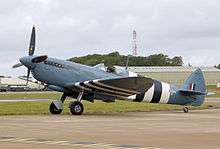
- Spitfire PR Mk.XI PL965 (G-MKXI). Operated by the Hangar 11 Collection at North Weald. The aircraft conducted over forty operational sorties with 16 Squadron 1944-45.[122]
- Spitfire PR Mk.XI PL983 (G-PRXI). Owned by the Aircraft Restoration Company, Duxford[123]. Ex RAF Photo-reconnaissance HQ and United States Embassy Flight. Restored to airworthy condition and flew in May 2018,[124] but suffered an undercarriage collapse on landing at Midden-Zeeland Airfield, Netherlands on 22 August 2019.[125]
- Spitfire Fr Mk.XIV MV293 (G-SPIT). Built in late 1944 and was sent to the Royal Indian Air Force in 1945. Nothing is known about its service in India, but the airframe was brought back to the UK in 1978 by Warbirds of Great Britain for restoration. Initially registered as G-BGHB but was later registered as G-SPIT before being acquired by The Fighter Collection and had its first flight after restoration in 1992. The plane used to be painted as an overall silver with codes OI-C to represent post-war RAF Spitfires, but in 2000, it was repainted in the markings of MV268/JE-J, the markings of Johnnie Johnson's Spitfire Mk.XIV[126].
- Spitfire F Mk.XIVe RN201 (G-BSKP). Delivered to Belgian Air Force in 1948 as SG.31, where it served until it was mounted on a plynth after retirement. It remained as a monument at Beauvechain until it was acquired by the Historic Aircraft Collection in 1990 for restoration. Restored by Historic Flying Limited in 2002 and was registered as G-BSKP[127]. In 2007 it was exported to the United States where it received the registration N201TB. It was cancelled in 2019 and exported to the UK[128] and re-registered as G-BSKP.
- Spitfire LF Mk.XVIe RW382 (G-PBIX). RW382 was built at Castle Bromwich in 1945 as a low back Mk.XVI and was delivered to No. 604 Squadron in 1947 before being retired in 1953. After starring in the Battle of Britain movie and being a gate guard at various RAF stations, it was rebuilt to fly in 1991 in original 604 Squadron markings as NG-C and registered G-XVIA. It was exported to the United States in 1995 and registered as N382RW[129] before it was lost in a fatal crash in 1998. The wreckage was later exported to the United Kingdom, rebuilt as a high back Spitfire, re-registered as G-PBIX and flew again in 2013 in No. 322 (Dutch) Squadron markings of 3W-P[130].
- Spitfire LF Mk.XVIe TB885 (G-CKUE). Ex 322 (Dutch) Squadron. Cut into sections and buried at RAF Kenley in 1958. Salvaged 1982. Restored to airworthy status by The Spitfire Company (Biggin Hill). Returned to the air on 4 August 2018. Now wearing TB885 / 3W-V of 322Sqn, she is owned by Dutchman Frits van Eerd, CEO of Dutch supermarket chain Jumbo, who intends to base it with the RNLAF Historical Flight at Gilze-Rijen Air Base.[94][131]
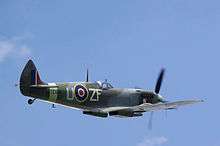
- Spitfire Mk.XVI TD248 (G-OXVI). Built in 1944 and entered service in 1945. It saw service with No.695 Squadron before being withdrawn from service in 1953. Displayed at Hooton Park, Cheshire before Historic Flying Ltd acquired the Spitfire and began restoration in 1988 for its first post-rebuild flight in 1992. the aircraft now wears the markings of a No. 74 Squadron Spitfire XVI[132], but the codes are the initials of its pilot: Cliff Spink[133].
- Spitfire LF Mk.XVIe TE184 (G-MXVI). Operated from the Biggin Hill Heritage Hangar, Biggin Hill, Kent. Since 2017, it has the colours and markings of 9N-B to represent the Mk.XVI flown by Czechoslovak ace Flt Lt Otto Smik who was Squadron Commander of 127 Squadron November 1944 Grimbergen Belgium. During June 2014 it was briefly marked as ZF-U of 308 (Polish) Squadron to replicate the mount of Jerzy Glowczewski (now aged 95), a veteran who had flown a similarly marked and coded Spitfire on 1 January 1945 when he claimed a Fw 190 over Ghent, Belgium. The Air Picnic at the Polish Air Museum in Kraków on Saturday 28 June 2014 was attended by both TE184 in these special markings and also Jerzy Glowczewski, allowing him to be reunited with a machine in 'his' markings. TE184 was brought to Poland for this occasion by Jacek Mainka, the first Pole ever to fly a Spitfire into and in Poland. Jacek's late grandfather, Ryszard Kwiatkowski, was a mechanic with 303 and 308 Squadrons during the war and saw Glowczewski off in ZF-U for that mission.
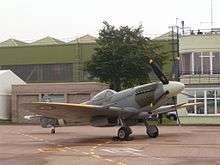
- Spitfire FR Mk.XVIIIe SM845 (G-BUOS). Imported from Sweden in 2012 following a fatal incident on 21 August 2010, it flew once again at Duxford on 17 December 2013. Owned by Spitfire Ltd and operated from both Duxford and Humberside. It wears the markings of Post-War (July 1950) 28 Squadron based in Hong Kong of overall silver with a red spinner and coded SM845 / -R.[134][135]
- Spitfire Mk. XIX PS853 (G-RRGN). Operated by Rolls-Royce Heritage Flight. Officially retired into ceremonial and display duties in 1957, PS853 was acquired by Rolls-‐Royce in 1996 after being operated for decades by the Battle of Britain Memorial Flight.
- Spitfire PR Mk.XIX PM631. Operated by the RAF Battle of Britain Memorial Flight at RAF Coningsby in Lincolnshire. Built as a high altitude reconnaissance aircraft in November 1945.[136] It currently wears the colours of a PR XIX from No 541 Squadron which performed photographic reconnaissance missions over the Europe from early 1944 to the end of the war.[137]
- Seafire LF. IIIc PP972 (G-BUAR). Owned by Air Leasing Ltd. Built in 1944 and delivered to 809 Squadron Fleet Air Arm before joining the Aeronavale (French Navy) as 12F.2 (later 1F.9). It was purchased by a private individual in 1970 and was on static display in 1982 at the Resistance Museum at St Marcel[138]. An airworthy restoration began in 1988 and was registered as G-BUAR. It was later acquired by Air Leasing in 2012 and was completed in 2015[139].
- Seafire F. XVII SX336 (G-KASX). Owned by Tim J. Manna, Cranfield. Built by Westland Aircraft in 1946. Served with various units in the Royal Navy before it was scrapped in 1955. It was recovered in the 70s as a bare fuselage and after a few owners, went to Tim Manna to finish the restoration. Took to the air for the first time since restoration in 2006[140].
- Static Display
.jpg)
- Spitfire F Mk.Ia K9942. On display at the Royal Air Force Museum, RAF Cosford wearing 72 (Basutoland) Squadron markings[141] as K9942 / SD-D. The markings replicate the ones it wore whilst serving with 'A Flight', 72 Squadron in 1939. This is the oldest Spitfire still in existence, being the 155th Spitfire built.[142]
- Spitfire F Mk.Ia P9444. On display at the Science Museum London wearing 72 (Basutoland) Squadron markings[143] as P9444 / RN-D with whom it served in 1940[144]
- Spitfire F Mk.Ia R6915. On display at the Imperial War Museum, London.[143] This aircraft flew during the Battle of Britain with 609 Squadron. Among the pilots who flew it were aces Noel Agazarian, who had two victories in this aircraft, and John Dundas, who scored one.[145]
- Spitfire Mk.Ia X4590. On display as part the Battle of Britain Experience at the Royal Air Force Museum, Hendon, in 609 Squadron markings[146] as X4590 / PR-F. These are the markings it wore when serving with 'A Flight' 609 Squadron from RAF Middle Wallop, October 1940. It is credited with ½ share of Ju-88 whilst being flown by Pilot P/O S. J. Hill on 21 October 1940.[147]
- Spitfire F Mk.IIA P7540. On display at the Dumfries and Galloway Aviation Museum at the former RAF Dumfries airfield. This aircraft was built at Castle Bromwich on 20 October 1940 and was first issued to 66 Squadron at Gravesend. Whilst being flown by Flying Officer Bobby Oxspring DFC** AFC, it was credited with shooting down a Messerschmitt Bf 109 during the Battle of Britain. On 25 October 1941, whilst being flown by Flying Officer Frantisek Hekl, 312 (Czech) Sqn from RAF Ayr, it crashed into Loch Doon. It was finally recovery from Loch Doon in 1982 and restored to static condition and finally revealed to the public in 2017.
- Spitfire F Mk.Vb AD540 (Blue Peter). On display at the Dumfries and Galloway Aviation Museum at the former RAF Dumfries airfield. This aircraft was paid for by funds raised by the people of Newmarket in 1941 and named after the winner of the 1939 Derby. During 1942, the aircraft was flying from RAF Ayr piloted by Pilot Officer David Gasphard Hunter Blair, RAFVR, tasked with providing air cover to the RMS Queen Mary troopship. During this mission, it was then tasked to intercept enemy aircraft inland. For some reason the pilot was forced to bail out from the aircraft, which subsequently crashed near Cairnsmore of Carspahairn. The pilot was tragically killed when his parachute failed to open. The aircraft was recovered by the Dumfries and Galloway Aviation Museum with help from a Royal Navy Sea King from HMS Gannet, on 12 July 1993 and featured on an episode of the TV show Blue Peter. Wreckage and Rolls Royce Merlin engine currently on display to the public in unrestored condition.
- Spitfire F Mk.Vb BL614. On display at the Royal Air Force Museum, Hendon, in 222 (Natal) Squadron markings.[148]
- Spitfire LF Mk.IXc ML427. On display at Thinktank, Birmingham Science Museum[149]
- Spitfire LF Mk.XVIe TB752. On display at the Hurricane and Spitfire Memorial Museum at the former RAF Manston in authentic Canadian 403 (Wolf) Squadron markings[150] as TB752 / KH-Z.
- Spitfire LF Mk.XVIe TE462. On display at the National Museum of Flight, Scotland.[151]
- Spitfire F Mk.21 LA198. Built in September 1944 at South Marston. Assigned to No 1 Sqn (RAF Manston). On 12 May 1947, allocated to 602 Sqn (City of Glasgow) Royal Auxiliary Air Force. Used in the Battle of Britain film. Aircraft is on display since the July 2006 reopening of Kelvingrove Art Gallery and Museum Glasgow.[152] It wears the markings LA198 / RAI-G and replicates the colours it wore during its 602 Squadron service.
- Spitfire F Mk.24 PK683. On display at Solent Sky in Southampton.[153]
- Spitfire F Mk.24 PK724. On display at the Royal Air Force Museum, Hendon.[154]
- Spitfire F Mk.24 VN485. A former Hong Kong Auxiliary Air Force aircraft on display at the Imperial War Museum Duxford[155] it wears an all-over silver scheme with a red/white spinner.
- Seafire F Mk.XVII SX137. On display at the Fleet Air Arm Museum, Yeovilton.[156]
- Restoration / Stored (Not on Public Display)
- Spitfire F Mk.Ia P9372 (G-CLIH). Under restoration to fly with the Biggin Hill Heritage Hangar, Biggin Hill, Kent, Dutch sources report she is owned by Dutchman Frits van Eerd, CEO of Dutch supermarket chain Jumbo.[157][158][79][159]
- Spitfire F Mk.Ia X4276 (G-CDGU). Under restoration to fly. Built in 1940 and delivered to 54 Squadron later that year and flown by F/Lt Al Deere with the codes KL-B and the name Kiwi III. It collided with X4650 in December 1940 (now airworthy in UK) and subsequently struck off charge. The remains were recovered in 1987 and has been registered G-CDGU for an airworthy restoration[160].
- Spitfire F Mk. IIa P7819 (G-TCHZ). Under restoration to fly. It became part of 9 Maintenance Unit before joining 303 Squadron in 1941. It was shot down later that year which killed F/O Mierszwa[161]. The remains were later recovered and acquired by Martin Phillips for an airworthy restoration[162].
- Spitfire F Mk. IIb P8331 (G-KOSC). Under restoration to fly. Ordered as part of a consignment of 1000 Mk.II aircraft on the 12th April 1939, P8331 was taken on charge from the Castle Bromwich Spitfire factory on the 12th March 1941. Delivered to 12 MU on the 4th April continuing on to 303 Sqn "Kosciuszko Squadron" based at RAF Northolt on the 13th May. P8331 would fly some 52 combat missions with 303 Sqn in the little over six weeks it was operational. Of the 15 pilots who flew the aircraft, eight were Battle of Britain veterans, including Canadian Johnny Kent, and Polish flying legends Wojciech Kolaczkowski, Boleslaw Drobinski, Waclaw Lapkowski, Piotr Laguna and Wiktor Strzembosz. P8331 was being flown by Lapkowski on the 4th June when it damaged an ME109 in combat over the English Channel between Dungeness and Cap Gris-Nez. On 17 June when being flown by Strzembosz it claimed a probable ME109 over Cap Gris-Nez again, and with the same pilot on the 23rd June had a confirmed ME109 kill Over North Desvres. Flown by Wing Commander Piotr Laguna leading the Northolt wing on a fighter offensive sweep on the Luftwaffe base at Coquelles on the 27th June 1941, P8331 was struck by ground fire and climbing for height Piotr was seen to bail out but was too low for his parachute to open.[163][164] P8331 impacted the ground just west of the airfield and was to remain buried until 1986 when it was recovered by local Archeologists with the assistance of the Calais War Museum. The wreckage remained within the museum and with a small number of local collectors until 2018 when efforts were made to reunite all the wreckage recovered. In April 2020 the substantial remains consisting of propellers and hub, engine, forward fuselage including the majority of the cockpit and fuselage structure were accepted onto the UK CAA registry.[165]
- Spitfire PR.IV AA810 (G-PRID). Under restoration to fly by Spitfire AA810 Restoration Ltd who have contracted restoration oversight to Kennet Aviation Ltd at Old Warden in Bedfordshire. Ordered in July 1940 as a MK1 fighter, this Spitfire was built at Vincents Garage in Reading in the summer of 1941. Test flown by Jeffrey Quill on 17 October 1941 it was delivered to 1 PRU at RAF Benson on 19 October. Assigned to C Flight, it was stationed at RAF Mount Farm in Oxfordshire until deployment to RAF Wick in Scotland in January 1942 as part of the hunt for Tirpitz. Shot down by Heinz Knoke and Dieter Gerhardt on 5 March 1943, AA810 spent the next 76 years sat on the side of a mountain near Surnadal in Norway. It was recovered in July 2018 and restoration began in March 2019.[166] AA810’s last pilot was Alastair Sandy Gunn[167] who parachuted to safety and was captured. He was later one of the 76 officers who escaped from Stalag Luft III, he was caught, and was of the 50 men executed on the orders of Adolf Hitler[168]
- Spitfire F Mk.Vb BL688 (G-CJWO). Currently being restored to flight by Parnall Aircraft Company. The aircraft flew Forward Air Control over the beaches of Normandy during D Day and remained active supporting ground troops and naval bombardment. [169]
- Spitfire F Mk.Vc EF545 (G-CDGY). Owned by Aero Vintage Ltd, Duxford. It was delivered to the RAAF in 1943 as A58-149 and assigned to 79 Squadron with the code "UP-O". EF545 flew in the RAAF until it was written off in 1944 after two landing accidents and a ground fire following a short circuit during an engine run. The remains were recovered in 1973 for (an incomplete) restoration which occurred in Australia, New Zealand and the UK. Some parts from this airframe were used to restore JG891, but EF545 is registered individually on the UK Civil Aviation Authority[170].
- Spitfire LF Mk.VIII JF872 (G-RAAF). Delivered to the RAAF as A58-328 and was struck off charge in 1948 [13]. Registered as G-RAAF in 2009 for an airworthy restoration.
- Spitfire F Mk.VIII JG668 (G-CFGA). Delivered to the RAAF as A58-441 and was struck off charge in 1948. Registered as G-CFGA to The Pembrokeshire Spitfire Aeroplane Company[13]
- Spitfire Tr.9 BS410 (G-TCHI). Under restoration to fly by Biggin Hill Heritage Hangar. This Spitfire joined 315 Squadron in 1942 and flew with the squadron until it crashed in 1943, taking F/O Piotr Kuryllowicz as Prisoner of War. The remains were recovered in 2005[162], acquired by Martin Phillips and sent to Biggin Hill to have it rebuilt to airworthy condition[171].
- Spitfire F Mk.IX EN179 (G-TCHO). Under restoration to fly. Built and first flown in 1942 before joining No. 315 Polish Fighter Squadron. It later served with No. 306 Polish Fighter Squadron and No. 316 Polish Fighter Squadron[172] as SZ-J (other codes listed but only one with photographic evidence) before being shot down on 19 August 1943, killing the pilot: F/O Andrzej Prochnicki. The wreckage was recovered in 2005.[173]
- Spitfire F Mk.IXc LZ842 (G-CGZU). Under restoration to flight at the Biggin Hill Heritage Hangar, Biggin Hill, Kent. It wears the markings LZ842 / EF-F. Restoration is progressing and the Rolls Royce Merlin X has now been fitted.[174] An ex-South African Air Force machine, which previously saw service with 93, 232 & 327 Sqns RAF.
- Spitfire LF Mk.IXc MK912 (G-BRRA). Built in 1944, this Spitfire flew for the RAF both during and after the Second World War for a number of different air forces, until being damaged in 1953. Passing through various collections, it was restored between 1992 and 2000, flying again on 8 September 2000. Previously owned and flown by Ed Russell in Niagara Falls, Ontario, MK912 was sold in 2011 to Peter Monk and based at the Biggin Hill Heritage Hangar, Biggin Hill, Kent.[175] Wears the authentic markings MK912 / SH-L.
- Spitfire LF Mk.IX PL258 (G-NSFS). Initially, with 39 Maintenance Unit[176], it was delivered to No.331 (Norwegian) squadron in 1944 and was involved in a mid-air collision with another Spitfire and belly-landed in the Netherlands. The remains were recovered in February 2018 and it is being restored to fly by the Aircraft Restoration Company at Duxford. The Spitfire will be based in Norway with the Norwegian Spitfire Foundation once the restoration is completed, along with a Norwegian civil register.[177]
- Spitfire F Mk. IX PT879 (G-PTIX). PT879 was built in 1944 and was delivered to Russia to be part of 2nd squadron, 767th Regiment, 122nd Division of the Russian Air force. After 29 hours of service, it crashed in 1945 and was recovered completely by a socialist-capitalist farmer (who may have seen value in the aircraft in the future). Peter Monk purchased the Spitfire in 1998 and brought it to the UK. It was later acquired by Peter Teichman, owner of the Hanger 11 Collection and is being restored to fly. It is hoped to be flying in 2020.[178]
- Spitfire LF Mk.IX TE517 (G-JGCA). Being rebuilt at Biggin Hill Heritage Hangar. Built and delivered to the RAF in 1945 with No. 313 Squadron RAF before being allocated to the Czech Air Force. The Israeli Air Force acquired the Spitfire in 1948 as 20-46. It was acquired by Robs Lamplough in 1977 and had the registration G-BIXP but not taken up. Charles Church acquired the remains in 1984 and had it registered as G-CCIX before being acquired by Kermit Weeks in 1992 after Charles Church's death[179]. It's now with Peter Monk at the Biggin Hill Heritage Hangar to be rebuilt to fly as G-JGCA [180].
- Spitfire F Mk.XII EN224 (G-FXII). Under restoration to airworthy condition at RAF Bentwaters in Suffolk. Previously stated that would be complete by June 2012.[181]
- Spitfire F Mk. XIVc RM689 (G-ALGT) In storage at East Midlands with Rolls Royce. Delivered to 350th Squadron in 1945 as MN-E[182] and later acquired by Rolls Royce in 1949 and refurbished to fly with the registration G-ALGT. It flew in the Battle of Britain movie with period accurate markings before returning to Rolls Royce. It was painted in the markings of RM619/AP-D of No. 130 Squadron before being repainted in original markings of RM689/MN-E of 350th Squadron. The Spitfire crashed during an airshow at Woodford Aerodrome in 1992 with the loss of the pilot and the civil registration cancelled by the CAA. Ten years later, the registration G-ALGT was re-assigned to RM689 for a new-build restoration by Rolls Royce Heritage Hangar before being moved to long term storage in 2010[183].
- Spitfire LF Mk.XVIe RW388. Under restoration at Rochester Airport. Formerly on display at the Potteries Museum & Art Gallery, Hanley, Stoke-on-Trent and planned to return to Stoke post-restoration. It was formally presented to the City of Stoke-on-Trent in 1972 and was built by the contractor Vickers Armstrong, in Castle Bromwich. It is fitted with a Merlin 266 (Packard) engine.[184][185]
- Spitfire LF Mk.XVIe SL611 (G-SAEA).[186] Remains in storage in Staffordshire.
- Spitfire PR Mk.XIX PS915. Under major refurbishment at Duxford. Operated by the RAF Battle of Britain Memorial Flight at RAF Coningsby in Lincolnshire. Entered service too late for the war, joining 541 Squadron at RAF Benson in June 1945.[187][188] Before entering refurbishment it wore the colours and markings of PS888, a PRXIX of 81 Squadron based at Seletar in Singapore during the Malaya Campaign. This aircraft conducted the last ever operational sortie by an RAF Spitfire when, on 1 April 1954, it flew a photographic mission over an area of jungle in Johore thought to contain hideouts for Communist guerrillas. For the occasion, the aircraft's ground crew painted the inscription 'The Last!’ on the left engine cowling[189]
- Spitfire F Mk. 22 PK519 (G-SPXX). Under restoration by Peter Arnold in the UK. Delivered to No. 615 Squadron in 1949[190] and lost in a collision with PK518. The wreckage was recovered in 2001 and Peter Arnold acquired it in 2012 for an airworthy restoration.[162]
- Seafire LF Mk.III RX168 (G-BWEM). Under restoration to airworthiness. Delivered to the IAC as 157 until becoming an instructional airframe in 1953. Possibly broken up in the 1960s, but became a restoration project in sometime after and registered G-BWEM in 1995[191].
- Seafire F Mk. XV SR462 (G-TGVP). Flew with the Burmese Air Force before being retired as a gate guard. It was recovered in the 1990's and was previously under restoration in Missouri before heading to the UK for restoration, registered G-TGVP.[192]
- Seafire F Mk. XVII SX300 (G-RIPH). Its military service is not well known, but it was recovered by Peter Arnold in 1973. It is now owned by Seafire Displays Ltd, Cayman Islands, but in the UK for restoration[193]
- Seafire F Mk.46 LA546 (G-CFZJ). Recovered in 1971 by Peter Arnold at the same time as LA564 for restoration[194]. According to the CAA, it is now registered to Craig Charleston as G-CFZJ.
- Seafire F Mk.46 LA564 (G-FRSX). Recovered in 1971 by Peter Arnold at the same time as LA546 for restoration[195]. According to the CAA, it is now owned by Seafire Displays Ltd, Cayman Islands, but in the UK for restoration to fly.
United States
- Airworthy
- Spitfire F Mk.Ia P9374 (N92SQ). Owned by Ellenville LLC. Restored to airworthy condition by Historic Flying Limited, made its first post-restoration flight at Duxford on 9 September 2011, registered as G-MKIA.[196]. Previously owned by the Mark One Partnership LLC at Duxford Airfield. In July 2017 it was sold to a private owner in the United States with the register N92SQ.[197] It wears the exact colours it wore flying with 92 Sqn from RAF Croydon when shot down on 24 May 1940, P9374 / -J, and it landed on the beach at Calais, France. It was flown by Flying Officer Peter Cazenove, who survived the crash and was taken prisoner by the Germans. He was held in Stalag Luft III and involved in the Great Escape.[79]
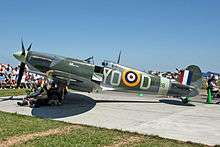
- Spitfire F Mk.Vb BL628 (N628BL). Owned by Lewis Air Legends and based at Encinal, Texas. It wears the markings BL628 / YO-D of 401 (RCAF) Squadron at RAF Gravesend, which it wore during 1942 as the personal aircraft of G. B. "Scotty" Murray. BL628 had the name Marion painted on the fuselage just forward of the cockpit after the pilot's girlfriend, and this detail has been faithfully replicated.[198]
- Spitfire F Mk.Vb EP122 (N5TF). Owned by Comanche Fighters, Texas. This Spitfire was built in 1942 and saw service in Malta with 249 Squadron, 185 Squadron and 1435 Squadron[199]. The aircraft crashed landed on 27 March 1943 on the cliffside of Dwejra Bay, Gozo and subsequently pushed over the cliff into the sea. The wreckage was recovered in the '70s and flew in the UK with the civil register G-CISV[200]. It starred in the 2017 film Dunkirk.[84] The plane was exported to the United States in 2018 and registered N5TF[92].
- Spitfire LF Mk.IXe MJ730 (N730MJ). Owned by Jerry Yagen and based at the Military Aviation Museum, Virginia Beach, Virginia. In April 1944 MJ730 was assigned to No. 417 Squadron RCAF, then operating in Italy. It flew 95 missions as an escort for American bombers over northern Italy. In June 1946, it was transferred to the Italian Air Force. In 1947, MJ730 was used in the film Thunderbolt!, directed by William Wyler. In 1951 it was sold to the Israeli Air Force, and after service ended up in an Israel playground. In the 1970s, a collector transported it back to Britain for restoration. FedEx founder Fred Smith bought it in 1986.[201][202][203]
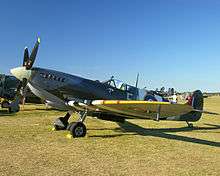
- Spitfire LF Mk.IXc MK959 (N959RT). Owned by the Texas Flying Legends Museum.[204]
- Spitfire LF Mk.IXe SL633 (N633VS). Owned by John Sessions with the Historic Flight Foundation and based at Felts Field, Spokane Washington. A historic machine that has served with the Royal Air Force, the Czechoslovakian Air Force, the fledgeling Israeli Air Force, and finally the Burmese Air Force. It wears the markings of the Czechoslovakian Air Force as SL633 / JT-10 of the 4th Air Regiment.[205]
- Spitfire FR Mk.XIVe NH749 (N749DP). Owned and operated by the Commemorative Air Force, based at Camarillo airport, Southern California. Built in late 1944 'NH749' was shipped to India in July 1945 to serve with the RAF's South East Asia Command (SEAC) squadrons. Rendered surplus to requirements by the Japanese surrender in August 1945 'NH749' was placed in storage and sold to the Indian Air Force in late 1947. In 1978 it was rediscovered and transported to England by the Hayden-Bailey brothers. After restoration to flying condition 'NH749' was sold to Keith Wickenden with the civil registration G-MXIV. 'NH749' was later sold to David Price's Museum of Flying in the United States and was operated from 1985 to 2005 when it was once again sold, this time to the CAF.[206] It wears a SEAC colour scheme with the markings NH749 / -L.
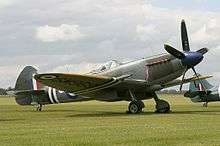
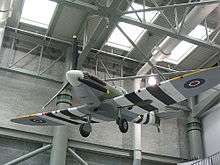
- Static Display
- Spitfire F Mk.Ia P9306 . On display at the Museum of Science and Industry in Chicago. It is a Battle of Britain veteran that flew with No. 74 Squadron RAF.[207]

- Spitfire F Mk.Vc MA863. On display at the National Museum of the United States Air Force, Wright-Patterson Air Force Base, near Dayton, Ohio.[208] It wears representative Operation Torch markings as MA863 / HL-B, 31st Fighter Group, 308th Fighter Squadron. Ex Royal Australian Air Force (RAAF) A58-246, it served with 54 Squadron (RAF) in early 1944 as the personal mount of Sqn Ldr E M Gibbs wearing the codes DL-A. Later served with 452 Squadron (RAAF) coded QY-F.[209]
- Spitfire LF Mk.VIIIc MT719 (N719MT). On display at the Cavanaugh Flight Museum, Dallas-Addison Airport, Texas. This aircraft served with No. 17 Squadron (RAF) in both India and Burma during 1944/1945. It was transferred to the Royal Indian Air Force at the end of 1947 and served as an instructional airframe.[210] Today it wears the markings and codes worn during its 17 Squadron service as MT719 / YB-J.
- Spitfire LF Mk.IXc MK923 (N521R). On display at the Museum of Flight in Seattle, Washington following acquisition in 2000.[211] This Spitfire was formerly owned by the late actor Cliff Robertson. From 1972 until 1994, it was flown by Jerry Billing, a Canadian Second World War Spitfire pilot, until he retired from flying Spitfires at age 75.[211] Billing set a record for most Spitfire experience while flying this Spitfire (521⁄2 years).[211] During Robertson's ownership and Billing's pilot tenure with MK923, the aircraft was mainly based in Windsor, Ontario, Canada. It wears the markings and codes it wore when serving with No. 126 Squadron at RAF Sawbridgeworth, Hertfordshire in mid to late 1944 as MK923 / 5J-Z.
- Spitfire PR Mk.XI PA908. On display at the National Museum of the United States Air Force, Wright-Patterson Air Force Base, near Dayton, Ohio.[212]
- Spitfire FR Mk.XIVe MT847. On display at the Pima Air and Space Museum in the USA.[213]
- Restoration / Stored (Not on Public Display)
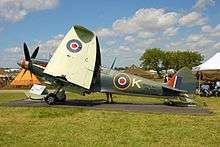
- Spitfire LF Mk.XVIe TE476 (N476TE). Owned by Kermit Weeks and under refurbishment at his Fantasy of Flight facility, Polk City, Florida.[214] It wears the markings and colours TE476 / GE-D to represent 'TB900' the personal mount of Sqn Ldr Lallemand OC, 349 (Belgian) Squadron RAF in 1945-1946. The original aircraft, 'TB900', was a presentation Spitfire named "Winston Churchill" and the name is faithfully replicated on Port side of the fuselage just below the cockpit along with the tally of aircraft kills and tank victories. Merlin engine fired up again on 14 January 2015 after 17 years of inactivity.[215]
- Seafire FR Mk.47 VP441 (N47SF). The final variant of the Spitfire family. Owned by Jim Smith and based at his private facility in Montana following restoration by Ezell Aviation.[216]
Zimbabwe
.jpg)
- Static Display
- Spitfire F Mk.22 PK355. On display at the Gweru Military Museum, Gweru, Zimbabwe since 1993. PK355 was built at the Castle Bromwich factory, Birmingham and delivered to the Southern Rhodesian AF as SR.65 on 28 March 1951, it transferred to the Royal Rhodesian AF as RRAF65 in October 1954. After its active service PK355 was initially displayed at the Bulawayo Museum from June 1955 to 1957, then went on to be displayed mounted on a plinth at Thornhill Air Base, Rhodesia between 1960 and 1981. Displayed between 1981 and 1990 at New Sarum Air Base in the Zimbabwe Air Force Museum before transferring to its current location.[217]
References
Notes
- Whitehead, Christopher. "The Supermarine Spitfire, an operational history ." Archived 4 September 2009 at the Wayback Machine DeltaWeb International Ltd, 1996. Retrieved: 30 August 2009.
- Graham, Steve. "The History of the Spitfire Development." Archived 8 September 2009 at the Wayback Machine The Spitfire Society, 14 March 1999. Retrieved: 30 August 2009.
- "OFMC Company Profile & History." Old Flying Machine Company, 2009. Retrieved: 30 August 2009.
- "Spitfire VIII." Archived 14 October 2006 at the Wayback Machine Temora Aviation Museum (AU). Retrieved: 29 September 2011.
- "Spitfire XVI." Archived 6 July 2011 at the Wayback Machine Temora Aviation Museum (AU). Retrieved: 29 September 2011.
- FAA Registry. Retrieved 13 October 2019
- "Aircraft Status". Lone Star Flight Museum - About Us. Lone Star Flight Museum. Archived from the original on 30 June 2013. Retrieved 2 July 2013.
- "Spitfire TE392" warbirdregistry.org Retrieved: 31 August 2009
- "Supermarine Spitfire TE392 to Australia | Warbirds Online". www.warbirdsonline.com.au. 20 February 2018.
- Supermarine Spitfire Mk.XVI TE392 flies in Australia!, Warbird News. Retrieved January 20 2020.
- "Spitfire P7973." warbirdregistry.org. Retrieved: 30 August 2009.
- "Vickers Supermarine Page" "Warbirds Directory website" Retrieved 21 November 2014
- "A58 Spitfire Page", "ADF Serials website" Retrieved 21 November 2014
- South Australian Aviation Museum. "Spitfire". Saam.org.au. Retrieved 9 April 2016.
- Studio, Cicada. "Supermarine Spitfire". raafawa.org.au. Retrieved 16 March 2018.
- "Australian Spitfire Round-Up" "Warbirds Online website" Retrieved 21 November 2014
- "Supermarine Spitfire MH 603 restoration update" "Warbirds Online website" Retrieved 21 November 2014
- "Arrival of Historic WWII Spitfire Wreckage Arrives in Australia for preservation" Archived 29 November 2014 at the Wayback Machine "Defence Australia website" Retrieved 21 November 2014
- "Spitfire SL721." warbirdregistry.org. Retrieved: 30 August 2009.
- AL721 Arrives at New Home, Aerodynamic Media. Created 19 March 2018. Retrieved 13 October 2019
- Airport Data, Registered 13 October 2019
- Warbirdregistry.org. Retrieved 10 June 2020
- Brussels Air Museum Restoration Society (BAMRS). Retrieved 10 June 2020
- "First flight for Vintage Wings of Canada’s Spitfire Mk IXe." worldwarbirdnews.com. Retrieved: 25 August 2017.
- "Aircraft Details". Canadian Warplane Heritage Museum. Retrieved 25 August 2018.
- Canada Aviation and Space Museum (2017). "Supermarine Spitfire Mark IIb". casmuseum.techno-science.ca. Retrieved 2 May 2017.
- "Spitfire NH188." warbirdregistry.org. Retrieved: 20 August 2009.
- Vintage Wings of Canada. "Identity Crisis". vintagewings.ca. Retrieved 22 February 2017.
- Harmsworth, Tony "Spitfire project arrives at Duxford." Aeroplane, Volume 37, Issue 11, November 2009, p. 4.
- "World War II Spitfire Sells for $1.9 Million in New Zealand." bloomberg.com. Retrieved: 29 September 2011.
- Spitfire TE565 Warbirds Registry. Last updated 2015. Retrieved 5 April 2020
- "Supermarine Spitfire P.R. Mk. XI." Danmarks Flymuseum. Retrieved: 29 September 2011.
- "Supermarine Spitfire PR XIX - PS890/UM-E". Touchdown Aviation. Archived from the original on 5 July 2017. Retrieved 12 June 2017.
- "VIDEO. L'avion capote au décollage à Longuyon-Villette : aucun mort, des blessés" [The aircraft overturned on take-off at Longuyon-Vilette: No death or injury] (in French). Le Republicain Lorrain. Retrieved 12 June 2017.
- Spitfire RR263, Warbirds Registry. Last updated 2002. Retrieved 2 March 2020
- MV370 warbirdregistry Retrieved: 30 March 2012.
- "Archived copy". Archived from the original on 11 June 2012. Retrieved 26 May 2012.CS1 maint: archived copy as title (link)
- "Supermarine Spitfire MV459". 18 November 2008. Retrieved 9 May 2020.
- "Supermarine Spitfire TE554." warbirdregistry.org. Retrieved: 31 August 2009.
- Misnikov, Avinoam. "Supermarine Spitfire" (in Hebrew). Archived 23 July 2011 at the Wayback Machine iafe.net. Retrieved: 18 December 2009.
- "EN145, American Air Museum in Britain, American Air Museum.com Retrieved: 2 January 2020.
- "Supermarine Spitfire EN145." warbirdregistry.org. Retrieved: 2 January 2020
- "Supermarine Spitfire TE578." warbirdregistry.org. Retrieved: 2 January 2020.
- "Archived copy". Archived from the original on 18 October 2008. Retrieved 20 August 2009.CS1 maint: archived copy as title (link)
- "Malta Aviation Museum-Ta' Qali-Malta". Maltaviationmuseum.com. Archived from the original on 2 September 2014. Retrieved 9 April 2016.
- AviationMuseum.eu "Defence Services Museum" AviationMuseum.eu website, Retrieved 19 February 2016.
- Brockman. Andy."Achtung Spitfires! or David Cameron’s Burmese daze." Heritage Daily website, 12 May 2012. Retrieved 14 October 2012.
- Eimer, David. "Green light for Burma's Spitfire hoard to be dug up" The Age, 18 October 2012.
- "Spitfires in Burma 'could be found'." BBC News.. Retrieved 14 April 2012.
- "British farmer’s quest to find lost Spitfires in Burma." Sunday Telegraph, 15 April 2012.
- "Archaeologists believe no Spitfires buried in Burma". BBC News, 18 January 2013. Retrieved 2 March 2013.
- Tweedie, Neil. "Search for lost Spitfires ends in failure for treasure hunters". Telegraph.co.uk. 18 January 2013. Retrieved 2 March 2013.
- "Search for 'buried Spitfires' in Burma called off". BBC News, 16 February 2013. Retrieved 2 March 2013.
- Mon, Kyaw Hsu. "Myanmar's Spitfire hunter turns to ground radar". The Myanmar Times, 21 February 2013. Retrieved 2 March 2013.
- "KLu Historische Vlucht :: Home". Skhv.nl. Archived from the original on 3 March 2016. Retrieved 9 April 2016.
- "Museum bound.htm". Angelfire.com. 28 May 1942. Retrieved 9 April 2016.
- Scott Rose, warbirdsresourcegroup.org. "Supermarine Spitfire Registry - A Warbirds Resource Group Site". Warbirdregistry.org. Retrieved 9 April 2016.
- "MH367 FL-A." Archived 26 October 2011 at the Wayback Machine Wings.org.nz. Retrieved 17 January 2009.
- "Forced landing of MH367." Times-age.co.nz. Retrieved: 17 January 2009.
- "Multi-million dollar spitfire crash". The New Zealand Herald. 3 December 2009. Retrieved 15 October 2011.
- Wade, Amelia (13 June 2011). "Spitfire takes a nose dive". The New Zealand Herald. Retrieved 15 October 2011.
- "Mixed Fortunes for NZ Spits." Aeroplane, Volume 37, No. 3, issue 431, March 2009, p. 5.
- "Virtual Hangar Tour". Spitfirepv270.co.nz. Retrieved 9 April 2016.
- "Introducing...'The Chariots of Fire Fighter Collection'." Archived 6 October 2011 at the Wayback Machine Omaka Aviation Heritage Centre. Retrieved: 21 June 2011.
- "Spitfire LF Mk.XVIe." The RNZAF Museum Aircraft Collection.
- "Spitfire TE456." warbirdregistry. Retrieved: 30 August 2009.
- "Spitfire TB252" Archived 29 January 2019 at the Wayback Machine platinumfighters. Retrieved 28 January 2019.
- Norwegian Aviation Museum - Aircraft on display Archived 26 August 2007 at the Wayback Machine Retrieved: 20 August 2009
- "Spitfire recovered in Norway". Aeroplane. Stamford: Key Publishing. 46, Number 10 (546): 6–7.
- "Aircraft: Supermarine Spitfire LF Mk.XVIE." Polish Aviation Museum Cracow. Retrieved: 29 September 2011.
- Simpson, Andrew (2013). "Individual History: De Havilland DH9A F1010 Museum Accession Number 77/A/921" (PDF). RAF Museum. Archived from the original (PDF) on 25 April 2016. Retrieved 16 April 2016.
- "Spitfire ML255." warbirdregistry.org. Retrieved: 31 August 2009.
- RESTAURACIJA AVIONA SPITFAJER IZ ZBIRKE MUZEJA JUGOSLOVENSKOG VAZDUHOPLOVSTVA, Đorđe čistogradov, Flight, no.3, Museum of Yugoslav Aviation, year 2004, ISSN 1450-684X
- Spitfajer, A. Kolo and B. Dimitrijević, Belgrade, 1997, ISBN 86-83005-01-1
- RESTAURACIJA AVIONA SPITFAJER IZ ZBIRKE MUZEJA JUGOSLOVENSKOG VAZDUHOPLOVSTVA, Đorđe Čistogradov, Flight, no.3, Museum of Yugoslav Aviation, year 2004, ISSN 1450-684X
- "Static, Surviving and under restoration Spitfires." strijdbewijs.nl. Retrieved: 29 September 2009.
- "Spitfire Restoration Project." The official website of the Spitfire Restoration Project for Spitfire N/S 5518. Retrieved: 5 April 2017.
- "Building 5: Helicopters and last propeller fighter." Archived 6 June 2011 at the Wayback Machine Royal Thai Air Force Museum. Retrieved: 11 January 2011.
- "MK1 Supermarine Spitfire to be sold to benefit RAF Veterans and Wildlife Charity". Cambridge Military History. 13 May 2015. Retrieved 9 April 2016.
- "Historic Flying Ltd". Aircraft Restoration Company. Retrieved 13 February 2020.
- Spitfire Mark I Archived 7 August 2017 at the Wayback Machine, Retrieved 24 January 2020
- "Spitfire/AR213." warbirdregistry.org. Retrieved: 13 September 2009.
- "Airworthy Spitfires based in the UK." military-airshows.co.uk. Retrieved: 13 September 2009.
- "Dunkirk – Filming the Aerial Scenes for the Epic Movie". Warbird Digest. Retrieved 18 March 2020.
- "Spitfire P7350." warbirdregistry.org. Retrieved: 10 September 2009.
- "Spitfire AB910." warbirdregistry.org. Retrieved: 10 September 2009.
- "Shuttleworth Spitfire flies". Aeroplane. Stamford: Key Publishing (541). May 2018. ISSN 0143-7240.
- "1942 - Supermarine Spitfire Vc." Shuttleworth Collection. Retrieved: 29 September 2011.
- Historic Aircraft Collection, Spitfire, Retrieved 27 January 2020
- "Friends of Mabel - Spitfire Restoration Project". friendsofmabel.co.uk. Archived from the original on 23 February 2017. Retrieved 22 February 2017.
- Spitfite EP120, The Fighter Collection. Retrieved 27 January 2020
- Federal Aviation Administration (19 May 2018). "N-Number Inquiry Results N5TF". Retrieved 19 May 2018.
- Supermarine Spitfire Mk VC JG891 Flies Again, Warbird News, created 6 July 2018, Retrieved 13 October 2019
- "Dutch combat vet Spitfire flies". Aeroplane. Stamford: Key Publishing. 45, Number 10 (October 2018): 9. ISSN 0143-7240.
- Aviation Safety Network, Created 6 October 2019. Accessed 13 October 2019
- "Pay's Warbird Collection". Warbirds Online. Retrieved 22 January 2016.
- "FAA Registry". Retrieved 7 December 2019.
- "Spitfire MH415". Platinum Fighter Sales. Retrieved 9 October 2015.
- Downunder Warbird Roundup, Warbird News. Published 16 April 2020. Retrieved 28 June 2020
- "Spitfire Mk IXB." Archived 22 July 2012 at the Wayback Machine Touchdown Aviation. Retrieved; 29 September 2011.
- Arnold, Peter R.; Kearns, Tony. "Spitfires over the Emerald Isle". Aeroplane. Stamford: Key Publishing. 44, Number 10 (October 2016): 40–48. ISSN 0143-7240.
- "Spitfire pilots return to Goodwood after round-the-world trip". BBC NEWS. 5 December 2019.
- "Hellenic Air Force Museum Exhibits". Archived from the original on 18 March 2012. Retrieved 18 April 2012.
- Spitfire MJ755 - 1943 SPITFIRE LF IX - Biggin Hill Heritage Hanger. Retrieved 18 December 2019
- "Spitfire crash lands in Kent field" Telegraph Online 7 September 2015. Retrieved: 7 September 2015.
- Williams, Samantha (7 September 2015). "Spitfire pilot makes emergency landing in a field in Woodchurch". Kentonline.co.uk. Retrieved 9 April 2016.
- "MJ772" "The Story of MJ772". Retrieved: 26 June 2019
- "Spitfire MK356." warbirdregistry.org. Retrieved: 10 September 2009.
- "The Grace Spitfire History". Official Grace Spitfire ML 407 Website. Retrieved 3 May 2017.
- "Archived copy". Archived from the original on 3 September 2014. Retrieved 30 August 2014.CS1 maint: archived copy as title (link)
- "Flight of restored Spitfire halted over technical hitch". BBC News. 11 March 2017. Retrieved 11 March 2017.
- FAA Registry N644TB, Retrieved 27 January 2020
- Historic Flying Limited Archived 27 January 2020 at the Wayback Machine. Retrieved 27 January 2020
- "Fly A Spitfire From Duxford - Spitfire Flights - Book Your Experience Online". Aerial Collective. Retrieved 13 February 2020.
- Osborne, Charles. "Spitfire RR232". www.flyingwithspitfires.com. Flying with Spitfires. Archived from the original on 23 November 2016. Retrieved 23 November 2016.
- "Scrapyard Spitfire fetches £1.7m." BBC News, 20 August 2009.
- "Kent Spitfire." kentspitfire.co.uk. Retrieved: 6 April 2008.
- The Aircraft, Retrieved 24 January 2020
- FAA registry, Retrieved 8 October 2019
- Biggin Hill Heritage Hangar, Fly a Spitfire, Retrieved 8 October 2019
- "G-AWGB | Supermarine Spitfire Mk.IX | Private | Terry Wade". JetPhotos.
- "The Hangar 11 Collection Home Page". Hangar11.co.uk. Retrieved 9 April 2016.
- "Spitfire L". Aircraft Restoration Company. Retrieved 13 February 2020.
- "PR Spitfire flies at Duxford". Aeroplane. Cudham: Kelsey Publishing Group (543): 6. July 2018. ISSN 0143-7240.
- "Historisch vliegtuig crasht op vliegveld Midden-Zeeland" [Historic aircraft crashed at Midden-Zeeland airfield] (in Dutch). Omroep Zeeland. 22 August 2019. Retrieved 23 August 2019.
- Warbirds Registry, Last updated 2002. Retrieved 22 January 2020
- Spitfire rn201, Last updated 2002. Retrieved 24 January 2020
- FAA Registration, Retrieved 24 January 2020
- Federal Aviation Authority aircraft registry, Retrieved 22 January 2020
- Biggin Hill Heritage Hangar, Retrieved 22 January 2020
- "Logbook Nr5-2017" (PDF). www.dutchdakota.nl. Dutch Dakota Association (PDF, in Dutch). Retrieved 4 November 2018.
- Flying Legends, Retrieved 22 January 2020
- Noarderljocht (translated to Northern Light) Retrieved 22 January 2020
- ""Global Aviation Review Article - SM845 Colours Revealed"". globalaviationresource.com. Archived from the original on 14 May 2014. Retrieved 16 March 2018.
- ""ASN Wikibase Occurrence # 76441"". aviation-safety.net. Retrieved 22 April 2019.
- "Spitfire PM631." warbirdregistry.org. Retrieved: 10 September 2009.
- "RAF BBMF - Spitfire PM631 (Mk PRXIX)". Raf.mod.uk. Retrieved 9 April 2016.
- Supermaraine Seafite LFIII, Retrieved 24 January 2020
- Seafire PP972, Last updated 2016. Retrieved 24 January 2020
- Aerial Visuals, Retrieved 27 January 2020
- Ellis 2008, p. 175.
- "Spitfire K9942". Warbird Registry. Warbirds Resource Group. Retrieved 9 April 2016.
- Ellis 2008, p. 147.
- "Spitfire P9444". Warbird Registry. Warbirds Resource Group. Retrieved 9 April 2016.
- "Spitfire R6915". Warbirds Resource Group. Retrieved 16 February 2012.
- Ellis 2008, p. 144.
- Warbirds Resource Group. "Spitfire X4590". Warbird Registry. Retrieved 9 April 2016.
- Ellis 2008, p. 142.
- Spitfire Mk IX. Aeroflight, Retrieved: 29 September 2011.
- Ellis 2008, p. 86.
- Ellis 2008, p. 281.
- "Spitfire LA198." Kelvingrove Art Gallery and Museum. Retrieved: 29 September 2011.
- "Vickers-Supermarine Type 356 Spitfire F.Mk.24 - PK683." Solent Sky. Retrieved: 29 September 2011.
- Ellis 2008, p. 143.
- Ellis 2008, p. 23.
- Ellis 2008, p. 192.
- "Logbook nr5-2017" (PDF). www.dutchdakota.nl. Dutch Dakota Association (PDF, in Dutch). Retrieved 4 November 2018.
- "Little Duxford in de polder". www.aironline.nl. Air Online (in Dutch). 15 September 2018. Retrieved 4 November 2018.
- "News from The Spitfire Company ( Biggin... - Biggin Hill Heritage Hangar Ltd". 18 July 2014. Retrieved 9 April 2016.
- Spitfire X4276 near Kirklevington, Yorkshire Aircraft. Retrieved 29 March 2020
- P7819. Retrieved 22 January 2020
- Vickers Supermarine Spitfire / Seafire. Last updated 14 July 2019. Retrieved 22 January 2020
- P8331, All Spitfire Pilots, . Retrieved 24 April 2020
- Laguana's Spitfire Legacy: owners of Spitfire P8331, Story of Wing Commander Piotr Łaguna. Retrieved 24 April 2020
- Laguana's Spitfire Legacy: owners of Spitfire P8331, Statement made 21 April 2020. Retrieved 24 April 2020
- About AA810, Spitfire AA810 website. Retrieved 20 October 2019
- The Men Spitfire AA810 website, "". Retrieved 20 October 2019
- The Great Escape, Spitfire AA810. Retrieved 20 October 2019
- Parnall Engineering Advanced Cornwall. "BL688". Parnall Group. Retrieved 13 February 2020.
- Pacific Wrecks, Last updated 23 October 2019. Retrieved 23 January 2020
- Biggin Hill 2017, Written 2017. Retrieved 22 January 2020
- Spitfire EN179, All Spitfire Pilots. Retrieved 7 May 2020
- Andrzej Prochnicki, Air Crew Remembered. Retrieved 7 May 2020
- "Spitfire restoration plans at Biggin Hill". FlyPast. Biggin Hill: Key Publishing Group (January 2016): 6.
- "Spitfire IX." Civil Aviation Authority. Retrieved: 29 September 2011.
- PL258, All Spitfire Pilots, Accessed 11 October 2019
- "Spitfire PL258 press release – Norwegian Spitfire Foundation".
- PT879 MK IX (in restoration) The Russian Spitfire. Retrieved 18 December 2019
- http://www.warbirdregistry.org/spitregistry/spitfire-te517.html Warbirds Registry. Last updated 2002. Retrieved 29 March 2020
- http://www.aerialvisuals.ca/AirframeDossier.php?Serial=8550 Aerial Visuals. Last updated 2009. Retrieved 29 March 2020
- "Spifire XII to fly". Aeroplane. Cudham: Kelsey Publishing Group (November 2011): 7.
- 350 (Belgian) Squadron. Retrieved 26 February 2020
- ASN Wikibase Occurrence # 19056, Aviation Safety Network. Last updated 15 February 2020, Retrieved 26 January 2020
- "Stoke Spitfire arrives at MAPS". Aeroplane. Vol. 46 no. 4. April 2018. p. 14. ISSN 0143-7240.
- "Stoke-on-Trent's own Spitfire." Archived 28 December 2008 at the Wayback Machine stoke.gov.uk. Retrieved: 27 March 2008.
- "Aircraft registration". UK Civil Aviation Authority. Retrieved 9 April 2016.
- "The Spitfire." warbirdregistry.org. Retrieved: 10 September 2009.
- "Spitfire PS915", Warbird Registry, retrieved 10 September 2009
- "Battle of Britain Memorial Flight - PS915 Page" Retrieved: 14 May 2014
- PK519 Spitfire pilots and aircraft database. Retrieved 27 February 2020
- Seafire RX168, Warbird Registry. Last updated 2002. Retrieved 20 June 2020
- Supermarine Seafire Mk. XV SR462 Could Become Airworthy in 2018. Aerodynamic Media. Published 22 November 2017. Retrieved 30 June 2020
- Seafire SX300 Warbird Registry. Last updated 2013. Retrieved 30 June 2020
- "Supermarine Spitfire Registry - A Warbirds Resource Group Site". www.warbirdregistry.org.
- "Supermarine Spitfire Registry - A Warbirds Resource Group Site". www.warbirdregistry.org.
- "Spifire Mk I airborne". Aeroplane. Cudham: Kelsey Publishing Group (November 2011): 6.
- Federal Aviation Administration (26 April 2018). "Make / Model Inquiry Results". Retrieved 26 April 2018.
- Spitfire BL628 Archived 17 May 2014 at the Wayback Machine Lewis Air Legends Website Retrieved: 15 May 2014.
- EP122, All Spitfire Pilots, Retrieved 13 October 2019
- Suprmarine Spitire Mk VB G-CISV, Flying Legends, retrieved 13 October 2019
- "Brigid McMenamin, Sweet Dreams and Flying Machines." Forbes, 9 December 2002. Retrieved: 14 May 2008.
- "Supermarine Spitfire". Fighter Factory. Retrieved 9 April 2016.
- "MJ730 (Walkaround)." detailsite3. Retrieved: 29 September 2011.
- "Tom Duffy Selling off Collection?". Retrieved 3 November 2015.
- SL633 BackstoryHistoric Flight Website - SL633 Page Retrieved: 15 May 2014.
- Spitfire NH749 Archived 11 December 2011 at the Wayback Machine Commemorative Air Force, Southern California. Retrieved: 12 November 2011.
- "Spitfire Mk.Ia P9306" Archived 13 June 2010 at the Wayback Machine Museum of Science and Industry (Chicago). Retrieved: 29 September 2011.
- "Supermarine Spitfire Mk Vc." National Museum of the United States Air Force. Retrieved: 13 September 2015.
- "Spitfire Mk.V MA863" ADF Serials - Spitfire Page 2 Retrieved: 20 May 2014.
- "Spitfire Mk.VIII MT719" Archived 6 December 2007 at the Wayback Machine Indian Air Force - Spitfires Retrieved: 20 May 2014.
- "Factsheets: Supermarine Spitfire Mk. IX." Archived 13 June 2010 at the Wayback Machine Museum of Flight. Retrieved: 21 April 2010.
- "Supermarine Spitfire PR.XI." National Museum of the United States Air Force. Retrieved: 13 September 2015.
- 63932 Aerial Visuals. Retrieved: 30 September 2019.
- "Spitfire." Fantasy of Flight. Retrieved: 29 September 2011.
- "Fantasy of Flight Facebook page" Fantasy of Flight Retrieved: 16 January 2015.
- "Supermarine Seafire Mk.47, N47SF / NX47SF / VP441 / 0-139, Privately owned." Air-Britain (Historians) Ltd, 2006. Retrieved: 30 August 2009.
- "VICKERS SUPERMARINE SPITFIRE / SEAFIRE" (PDF). Goodall.com.au. Retrieved 9 April 2016.
Bibliography
- Deere, Brendon. Spitfire:Return to Flight. Palmerston North, New Zealand: ITL Aviation Limited, 2010. ISBN 978-0-473-16711-0
- Green, Peter. "Spitfire Against a Lightning." FlyPast, No. 315, October 2007.
- Price, Alfred. Spitfire: Fighter Supreme. London: Arms & Armour, 1991. ISBN 1-85409-056-9.
- Ellis, Ken (2008). Wrecks and Relics. Manchester: Crecy Publishing. ISBN 978-0-85979-134-2.CS1 maint: ref=harv (link)
External links
| Wikimedia Commons has media related to Supermarine Spitfire warbirds. |
| Wikimedia Commons has media related to Supermarine Spitfire museum aircraft. |
- Supermarine Spitfire Registry
- Flying and Preserved Spitfires around the World
- Spitfires based in the UK
- Belgian AF aircraft used from 1945-today
- Wreckhunters info on Belgian AF Spit 'SG57'
- MK1 Supermarine Spitfire to be sold to benefit RAF Veterans and Wildlife Charity at cambridgemilitaryhistory.com weblog